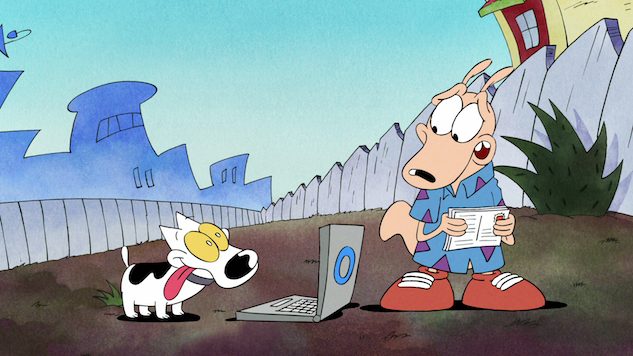Rocko’s Modern Life: Static Cling Is More than a Nostalgia Play
The iconic cartoon returns with a new twist.
Photo Courtesy of Netflix
It’s been 23 years since Rocko’s Modern Life went off the air. A progenitor of SpongeBob SquarePants, with much of the cast and creative team moving on from one show to the next, the satire was Nickelodeon’s in-house answer to its more troublesome The Ren & Stimpy Show. And it was sharp. Deranged. Relatable. Ripped from the daily lives of its writers and unlike any other cartoon airing on TV. Now, animation has come out the other side. Netflix’s BoJack Horseman is one of the most elevated shows about depression, loss, and trauma. Comedy Central’s South Park started skewering headlines a year after Rocko went off the air and hasn’t stopped yet. So now, with the 45-minute special Rocko’s Modern Life: Static Cling coming to Netflix, how does the original spirit of the show persist? Like any good revival, it makes a point of being familiar but different.
Original creator Joe Murray is back on writing and directing duties, alongside all the voice actors (Carlos Alazraqui, Tom Kenny, and Mr. Lawrence) returning to play Rocko, Heffer, and Filburt. The companions, who would feel right at home in either Office Space or a zoo, have been canonically lost in space for two decades since the series finale and finally figure out a way back to Earth. These cartoonish Rips Van Winkle didn’t miss the American Revolution, but they certainly missed enough.
With a meta plotline about the cancellation and subsequent rebooting of a beloved cartoon, Static Cling isn’t afraid to be self-effacing about the revival process—or poke a little fun at the fanatical cult audience that got it a second run at Netflix in the first place. “An old cartoon isn’t going to solve the kinds of problems you have,” Rocko’s neighbor, Mr. Bighead, tells him. It’s a bit of a middle finger to its viewers, but a loving one. It’s hard to be counter-cultural and rebellious when the very existence of a revived special means that some version of success awakened the corporate overlords.
Much of what made the show a fan-favorite is still here. Its color-packed, neo-Fleischer Brothers animation (with surreal, askew Chuck Jones backgrounds and images that are just funny enough not to be disturbing, like Rocko’s visible optic nerves when his eyes flying out of his head) and expansive vocabulary balance its fart gags and butt jokes. It’s warm and nostalgic, but only in the sense that its aesthetic maintains a dedication to strangeness. There are also strides forward. Moving on from the ‘90s hasn’t all been overwhelming technology and scary surveillance.
-

-

-

-

-

-

-

-

-

-

-

-

-

-

-

-

-

-

-

-

-

-

-

-

-

-

-

-

-

-

-

-

-

-

-

-

-

-

-

-








































